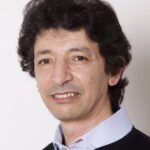Link to Pubmed [PMID] – 16115459
Link to HAL – inserm-00104686
Link to DOI – 10.1051/medsci/2005218-9737
médecine/sciences, 2005, 21 (8-9), pp.737-40. ⟨10.1051/medsci/2005218-9737⟩
Une description phénoménologique précise de la différenciation de la touffe ciliaire des cellules sensorielles de l’oreille interne a été réalisée il y a environ 20 ans chez le poulet. Pourtant, les mécanismes cellulaires concourant à la formation de cette structure remarquablement organisée, qui assure la transformation d’un son ou d’une accélération en un signal électrique (transduction mécano-électrique), demeurent très mal connus. Récemment, par des approaches génétiques conjointes chez l’homme et la souris, cinq des protéines directement impliquées dans le syndrome de Usher de type I, un double deficit sensoriel qui concerne à la fois l’audition et la vision, ont pu être caractérisées. Ces découvertes ont d’ores et déjà permis d’identifier les liens interstéréociliaires comme des acteurs essentials de la différenciation des touffes ciliaires.
Defects in myosin VIIa, the PDZ-domain-containing protein harmonin, cadherin 23, protocadherin 15, and the putative scaffolding protein sans, underlie five genetic forms of Usher syndrome type I (USH1), the most frequent cause of hereditary deafness-blindness in humans. Mice mutants defective for any of these proteins have a severe hearing impairment and display similar inner ear phenotypes characterized by the abnormal spreading of the sensory cells’ stereocilia. These are highly specialized mechanoreceptive organelles derived from microvilli, that normally form a well-structured hair bundle at the apex of inner ear sensory cells. All the USH1 proteins, except sans, have been detected in the growing stereocilia. Moreover, biochemical studies have started to unravel the multiple direct molecular interactions between USH1 proteins. In particular, harmonin can bind to the other four USH1 proteins and to F-actin. Finally, cell biology studies have provided the first insights into the functions of these proteins, and revealed that cadherin 23, and probably protocadherin 15 also, are associated with transient lateral links that interconnect growing stereocilia. These connectors play a critical role in the differentiating hair bundle.


